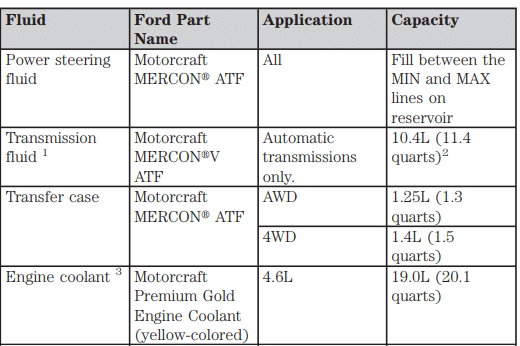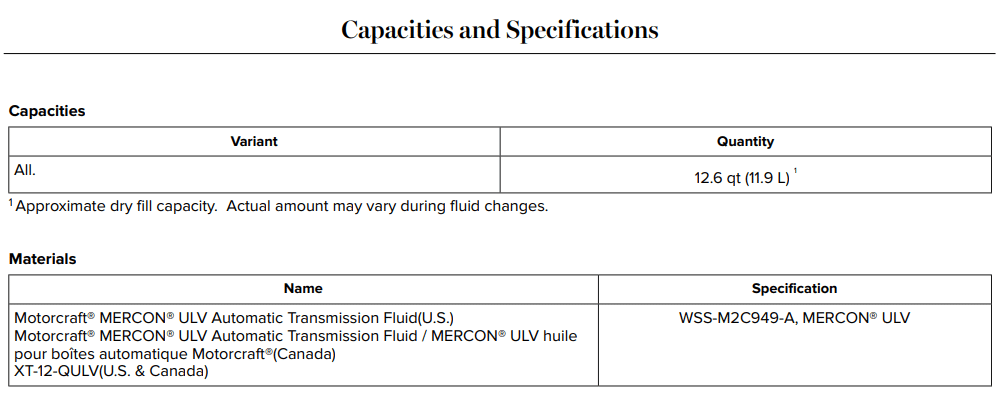The Lincoln Aviator, a brand name synonymous with luxury and performance, has consistently proven itself as a leader in its class. Central to this prowess is its advanced transmission system, a piece of engineering that’s as intricate as it is vital.
The Aviator’s transmission system is responsible for channeling the engine’s power to the wheels, ensuring smooth gear transitions and optimized performance across various driving conditions.
It is a perfect blend of mechanical, hydraulic, and electronic components working in unison to give drivers a seamless driving experience.

However, like any finely-tuned machine, the transmission’s efficacy relies heavily on its lubrication: the transmission fluid. This fluid plays several crucial roles:
- Cooling: It dissipates heat generated during gear shifts and high-speed travel.
- Lubrication: Reduces friction among the moving parts, preventing wear and tear.
- Transmission of Force: Acts as a hydraulic fluid, aiding in the operation of the transmission’s internal components.
- Cleaning: Helps keep the transmission clean by suspending dirt and contaminants.
The importance of regular transmission fluid maintenance cannot be stressed enough. With time and usage, the fluid degrades and can accumulate contaminants, affecting its ability to function correctly.
Not only can degraded fluid impair the Aviator’s performance, but it can also lead to premature wear or even irreversible damage to the transmission system.
Regular checks and timely fluid replacements ensure that your Lincoln Aviator continues to deliver the superior performance you’ve come to expect, while also ensuring a longer lifespan for the transmission system.
In essence, just as our body requires clean blood to function optimally, the Lincoln Aviator’s transmission requires clean, high-quality fluid to maintain its peak performance.
Regular maintenance is more than just a routine; it’s an investment in the continued excellence of your vehicle.
2003-2005 Lincoln Aviator Transmission Fluid Capacity And Type
The first generation Lincoln Aviator, which spanned from 2003 to 2005, was introduced as a luxury mid-size SUV that shared a platform with the Ford Explorer. Equipped with a robust transmission system, maintaining this component is paramount for the vehicle’s longevity and performance.

- Transmission Fluid Capacity:
- For the 1st Gen Lincoln Aviator, the approximate transmission fluid capacity for a full change is around 11.4 quarts (10.4 L). However, keep in mind that during a standard fluid change, not all the old fluid might be removed, so you might not use the entire capacity.
- Recommended Fluid Type:
- For the UN152 Lincoln Aviator, the recommended transmission fluid is the Mercon V ATF (Automatic Transmission Fluid). Ensure you always use the manufacturer-specified fluid type, as using a different kind can lead to decreased performance and potential transmission issues.
- Fluid Change Intervals:
- Generally, for vehicles of this generation, a good practice is to change the transmission fluid every 30,000 to 60,000 miles. However, if the vehicle is frequently used under strenuous conditions, such as towing or driving in extreme temperatures, it’s advisable to inspect and potentially change the fluid more often.
It’s important to note that while these are general guidelines, the best practice is always to refer to the specific vehicle’s owner’s manual. The manual will provide detailed specifications and intervals tailored for the particular make and model of the vehicle.
Regular maintenance following the manufacturer’s recommendations ensures your Lincoln Aviator’s transmission operates efficiently and prolongs its lifespan.
2020-Now Lincoln Aviator Transmission Fluid Capacity And Type
The second generation Lincoln Aviator, starting in 2020, represents Lincoln’s renewed vision for luxury mid-size SUVs.
With advancements in technology and engineering, the Aviator’s transmission system is more sophisticated than ever, emphasizing the need for meticulous maintenance.

- Transmission Fluid Capacity:
- For the 2nd Gen Lincoln Aviator, the approximate transmission fluid capacity for a full change varies depending on the exact model and transmission type. As for the ten-speed automatic transmission (10R60), the capacity is 12.6 qt (11.9 L) for a full fluid change.
However, it’s essential to note that during a standard transmission service, you may not remove and replace all of this fluid.
- For the 2nd Gen Lincoln Aviator, the approximate transmission fluid capacity for a full change varies depending on the exact model and transmission type. As for the ten-speed automatic transmission (10R60), the capacity is 12.6 qt (11.9 L) for a full fluid change.
- Recommended Fluid Type:
- For the U611 Lincoln Aviator, the manufacturer recommends the Mercon ULV ATF (Automatic Transmission Fluid). This fluid type is designed for newer transmission architectures to provide better fuel efficiency and improved shift performance.
Always ensure that you’re using the specified fluid to maintain optimal transmission performance and safeguard against potential issues.
- For the U611 Lincoln Aviator, the manufacturer recommends the Mercon ULV ATF (Automatic Transmission Fluid). This fluid type is designed for newer transmission architectures to provide better fuel efficiency and improved shift performance.
- Fluid Change Intervals:
- Modern vehicles, with their advanced transmission systems and higher-quality fluids, often have longer service intervals. For the 2nd Gen Lincoln Aviator, it’s generally advisable to change the transmission fluid every 100,000 miles.
However, always consider the driving conditions: vehicles frequently subjected to severe conditions (e.g., heavy towing, extensive idling, or extreme climates) might require more frequent fluid checks and changes.
- Modern vehicles, with their advanced transmission systems and higher-quality fluids, often have longer service intervals. For the 2nd Gen Lincoln Aviator, it’s generally advisable to change the transmission fluid every 100,000 miles.
Once again, the most accurate and tailored advice will come from the Lincoln Aviator’s owner’s manual for the specific year and model in question.
Regularly adhering to the manufacturer’s guidelines is the key to ensuring the longevity and peak performance of your Lincoln Aviator’s transmission.
General Tips for Checking & Changing Transmission Fluid
Maintaining your vehicle’s transmission fluid is essential for its longevity and performance. Here’s a general guide to help you safely and effectively check and change the transmission fluid:
Safety Precautions
- Vehicle Stability: Ensure the vehicle is on a level surface. If using jacks, ensure they are sturdy, and always use jack stands for additional safety.
- Protective Gear: Wear gloves and safety goggles to protect against any fluid splashes.
- Ventilation: If working in an enclosed space, make sure it is well-ventilated. Transmission fluid fumes can be harmful.
- Engine Caution: Remember that the engine and transmission can be hot, especially if the car was running recently. Allow it to cool before starting the process.
Necessary Equipment
- Dipstick or Fluid Level Check Tool: For checking the fluid level.
- Drain Pan: To collect old transmission fluid.
- Funnel: For adding new fluid.
- Transmission Fluid: Ensure it’s the type recommended for your vehicle.
- Wrenches or Socket Set: For removing the transmission pan or drain plug.
- New Transmission Filter (if applicable): It’s a good idea to replace this when changing the fluid.
- Jack and Jack Stands: If you need to elevate the vehicle.
Procedure for Checking Fluid Levels
- Warm-Up: Start the vehicle and let it run for a few minutes. Some vehicles require a warm transmission for accurate fluid level readings.
- Locate Dipstick: Find the transmission fluid dipstick (usually labeled). If your vehicle doesn’t have a dipstick, it might have a fluid level check plug instead.
- Check Fluid: Pull out the dipstick, wipe it clean, reinsert it fully, and then pull it out again to check the level. The fluid should be between the “Full” and “Add” marks. Also, note the color and smell. Fresh fluid is typically bright red and shouldn’t have a burnt odor.
Procedure for Changing Fluid
- Draining the Fluid: Position the drain pan beneath the transmission pan. If there’s a drain plug, remove it. Otherwise, you might need to loosen the transmission pan bolts to drain the fluid.
- Remove and Clean the Pan: Once drained, remove the transmission pan entirely, clean it, and replace the filter if your vehicle has one.
- Replace the Gasket: If the gasket is damaged or worn, replace it.
- Reattach the Pan: Secure the transmission pan back in place. Ensure the bolts are tightened to the manufacturer’s specifications.
- Add New Fluid: Using a funnel, add the new transmission fluid through the dipstick tube or fill port. Be careful not to overfill. Check the vehicle’s manual for fluid capacity.
- Run the Vehicle: Start the engine and let it run for a few minutes. Shift through all gears and then back to park or neutral.
- Recheck Fluid Level: With the engine running, check the fluid level again using the dipstick. Top up if necessary.
Always remember to refer to the specific service manual or owner’s manual for your vehicle, as there may be model-specific steps or requirements. Properly disposing of the old transmission fluid is also crucial. Most auto parts stores or service centers will accept used fluids for recycling.
General Recommendations On Lincoln Aviator Transmission Fluid Change Intervals
When it comes to luxury SUVs like the Lincoln Aviator, maintaining the transmission system is crucial for the vehicle’s longevity, performance, and overall driving experience. Regularly changing the transmission fluid is an essential aspect of this maintenance. Here are general recommendations for the Lincoln Aviator’s transmission fluid change intervals:
General Recommendations
- Standard Driving Conditions:
- For most modern vehicles, including the Lincoln Aviator, manufacturers often suggest transmission fluid changes every 60,000 to 100,000 miles under standard driving conditions. This includes regular commutes, highway drives, and occasional light towing.
- Severe Driving Conditions:
- If the vehicle is frequently exposed to more severe driving conditions, it’s advisable to change the transmission fluid more frequently. Severe conditions include:
- Consistent stop-and-go traffic.
- Regular towing or carrying heavy loads.
- Driving in very hot or cold climates.
- Extensive idling or frequent short-distance drives.
- Under these circumstances, consider changing the fluid every 30,000 to 60,000 miles.
- If the vehicle is frequently exposed to more severe driving conditions, it’s advisable to change the transmission fluid more frequently. Severe conditions include:
- Checking the Fluid:
- It’s a good practice to check the transmission fluid’s level and quality every 20,000 to 30,000 miles or during your regular service intervals. If the fluid is discolored (not a clear reddish color), smells burnt, or is below the recommended level, it might be time for a change or a top-up.
- Older Vehicles:
- For older models or vehicles with higher mileage (over 100,000 miles) that have never had a transmission fluid change, it’s essential to consult with a mechanic or specialist. Sometimes, changing the fluid in such cases can lead to transmission issues if the system has adjusted to operating with degraded fluid over time.
- Always Refer to the Owner’s Manual:
- The manufacturer’s recommendations in the owner’s manual should always take precedence over general advice. The manual will provide the most accurate and tailored advice for your specific vehicle model and year.















